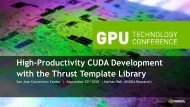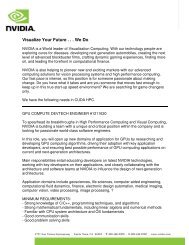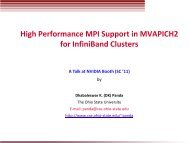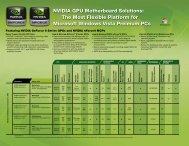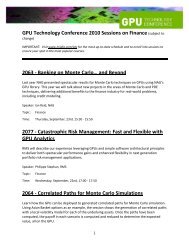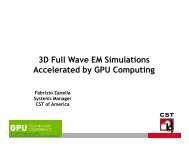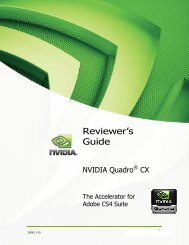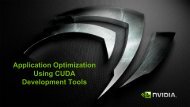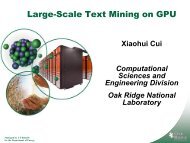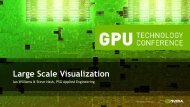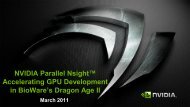You also want an ePaper? Increase the reach of your titles
YUMPU automatically turns print PDFs into web optimized ePapers that Google loves.
OpenCL <strong>on</strong> <strong>the</strong> <strong>GPU</strong><br />
San Jose, CA | September 30, 2009<br />
Neil Trevett and Cyril Zeller, NVIDIA
Welcome to <strong>the</strong> OpenCL Tutorial!<br />
• Khr<strong>on</strong>os and industry perspective <strong>on</strong> OpenCL<br />
– Neil Trevett<br />
Khr<strong>on</strong>os Group President<br />
OpenCL Working Group Chair<br />
NVIDIA Vice President Mobile C<strong>on</strong>tent<br />
• NVIDIA and OpenCL<br />
– Cyril Zeller<br />
NVIDIA Manager of Compute Developer Technology
Khr<strong>on</strong>os and <strong>the</strong><br />
OpenCL Standard<br />
Neil Trevett<br />
OpenCL Working Group Chair, Khr<strong>on</strong>os President<br />
NVIDIA Vice President Mobile C<strong>on</strong>tent<br />
Copyright Khr<strong>on</strong>os 2009
Who is <strong>the</strong> Khr<strong>on</strong>os Group?<br />
• C<strong>on</strong>sortium creating open API standards ‘by <strong>the</strong> industry, for <strong>the</strong> industry’<br />
– N<strong>on</strong>-profit founded nine years ago – over 100 members - any company welcome<br />
• Enabling software to leverage silic<strong>on</strong> accelerati<strong>on</strong><br />
– Low-level graphics, media and compute accelerati<strong>on</strong> APIs<br />
• Str<strong>on</strong>g commercial focus<br />
– Enabling members and <strong>the</strong> wider industry to grow markets<br />
• Commitment to royalty-free standards<br />
– Industry makes m<strong>on</strong>ey through enabled products – not from standards <strong>the</strong>mselves<br />
Silic<strong>on</strong><br />
Community<br />
Software<br />
Community<br />
Copyright Khr<strong>on</strong>os 2009
Apple<br />
Over 100 companies creating<br />
authoring and accelerati<strong>on</strong> standards<br />
Board of Promoters
Processor Parallelism<br />
CPUs<br />
Multiple cores driving<br />
performance increases<br />
Multi-processor<br />
programming –<br />
e.g. OpenMP<br />
Emerging<br />
Intersecti<strong>on</strong><br />
Heterogeneous<br />
Computing<br />
<strong>GPU</strong>s<br />
Increasingly general purpose<br />
data-parallel computing<br />
Improving numerical precisi<strong>on</strong><br />
Graphics APIs<br />
and Shading<br />
Languages<br />
Copyright Khr<strong>on</strong>os 2009
OpenCL Commercial Objectives<br />
• Grow <strong>the</strong> market for parallel computing<br />
• Create a foundati<strong>on</strong> layer for a parallel computing ecosystem<br />
• Enable use of diverse parallel computati<strong>on</strong> resources in a system<br />
• Support a wide diversity of applicati<strong>on</strong>s<br />
• Applicati<strong>on</strong> portability across diverse systems from many vendors<br />
• Close coordinati<strong>on</strong> with silic<strong>on</strong> roadmaps<br />
– OpenCL 1.0 designed to run <strong>on</strong> current <strong>GPU</strong> hardware for fast roll-out<br />
– THEN evolve specificati<strong>on</strong> to expose and inspire future silic<strong>on</strong> capabilities<br />
Copyright Khr<strong>on</strong>os 2009
OpenCL Working Group<br />
• Diverse industry participati<strong>on</strong><br />
– Processor vendors, system OEMs, middleware vendors, applicati<strong>on</strong> developers<br />
• Many industry-leading experts involved in OpenCL’s design<br />
– A healthy diversity of industry perspectives<br />
• Apple made initial proposal and is very active in <strong>the</strong> working group<br />
– Serving as specificati<strong>on</strong> editor
The Khr<strong>on</strong>os API Ecosystem<br />
3D Asset Interchange<br />
Format<br />
Cross platform<br />
desktop 3D<br />
Desktop 3D<br />
Ecosystem<br />
OpenCL - <strong>the</strong> center of an visual computing<br />
ecosystem with parallel computati<strong>on</strong>, 3D,<br />
video, audio and image processing <strong>on</strong><br />
desktop, embedded and mobile systems<br />
Parallel computing and<br />
visualizati<strong>on</strong> in scientific and<br />
c<strong>on</strong>sumer applicati<strong>on</strong>s<br />
Heterogeneous<br />
Parallel Programming<br />
Streaming Media and<br />
Image Processing<br />
Enhanced Audio<br />
Embedded 3D<br />
Vector 2D<br />
Hundreds of man years<br />
invested by industry experts<br />
in coordinated ecosystem<br />
Streamlined APIs for mobile and<br />
embedded graphics, media and<br />
compute accelerati<strong>on</strong><br />
Surface and<br />
synch abstracti<strong>on</strong><br />
Mobile OS Abstracti<strong>on</strong><br />
Copyright Khr<strong>on</strong>os 2009
OpenCL / OpenGL Interoperability<br />
• OpenCL can efficiently share resources with OpenGL<br />
– Applicati<strong>on</strong>s use a graphics or compute API that best fits each part of <strong>the</strong>ir problem<br />
• Data is shared, not copied between <strong>the</strong> two APIs<br />
– OpenCL objects are created from OpenGL objects<br />
– Textures, Buffer Objects and Renderbuffers<br />
• Applicati<strong>on</strong>s can select devices to run OpenGL and OpenCL<br />
– Efficient queuing of OpenCL and OpenGL commands into <strong>the</strong> hardware<br />
– Flexible scheduling and synchr<strong>on</strong>izati<strong>on</strong><br />
– Works <strong>on</strong> single <strong>GPU</strong> and multi-<strong>GPU</strong> systems<br />
Textures, buffers<br />
and events<br />
Copyright Khr<strong>on</strong>os 2009
OpenCL 1.0 Embedded Profile<br />
• OpenCL is not just for ‘big ir<strong>on</strong>’<br />
• Embedded profile relaxes some data<br />
type and precisi<strong>on</strong> requirements<br />
• Intent to enable OpenCL <strong>on</strong> mobile and<br />
embedded silic<strong>on</strong> in next few years<br />
• Avoids <strong>the</strong> need for a separate “ES” spec<br />
• Khr<strong>on</strong>os mobile API ecosystem defining<br />
tightly interoperable compute, imaging<br />
& graphics<br />
• Watch out for OpenCL in mobile ph<strong>on</strong>es,<br />
automotive, avi<strong>on</strong>ics… A c<strong>on</strong>cept GPS ph<strong>on</strong>e processes<br />
images to recognize buildings and<br />
landmarks and uses <strong>the</strong> internet to<br />
supply relevant data<br />
Copyright Khr<strong>on</strong>os 2009
OpenCL Timeline<br />
• Six m<strong>on</strong>ths from proposal to released OpenCL 1.0 specificati<strong>on</strong><br />
– Due to a str<strong>on</strong>g initial proposal and a shared commercial incentive<br />
• Apple’s Mac OS X Snow Leopard now ships with OpenCL<br />
– Improving speed and resp<strong>on</strong>siveness for a wide spectrum of applicati<strong>on</strong>s<br />
Jun08<br />
Apple proposes<br />
OpenCL working<br />
group and<br />
c<strong>on</strong>tributes draft<br />
specificati<strong>on</strong> to<br />
Khr<strong>on</strong>os<br />
Khr<strong>on</strong>os publicly<br />
releases OpenCL<br />
1.0 as royalty-free<br />
specificati<strong>on</strong><br />
Dec08<br />
May09<br />
Khr<strong>on</strong>os releases<br />
OpenCL 1.0<br />
c<strong>on</strong>formance tests to<br />
ensure high-quality<br />
implementati<strong>on</strong>s<br />
Multiple c<strong>on</strong>formant<br />
implementati<strong>on</strong>s ship<br />
across diverse OS and<br />
platforms<br />
2H09<br />
1H10<br />
Developer feedback and<br />
silic<strong>on</strong> advances feed<br />
into OpenCL 1.1<br />
specificati<strong>on</strong> release<br />
We are here!<br />
Seeking developer feedback to<br />
refine OpenCL 1.1<br />
Copyright Khr<strong>on</strong>os 2009
OpenCL C<strong>on</strong>formance<br />
• A standard without str<strong>on</strong>g testing for c<strong>on</strong>formance is not a standard at all<br />
– Streng<strong>the</strong>ns c<strong>on</strong>sistency of cross-vendor implementati<strong>on</strong>s<br />
– Creates a reliable platform for software developers<br />
• OpenCL has a an exhaustive set of c<strong>on</strong>formance tests<br />
– Precisi<strong>on</strong> and functi<strong>on</strong>ality testing<br />
• Khr<strong>on</strong>os Administers an OpenCL Adopters Program<br />
– Full source access to tests for small fee<br />
– Peer review of uploaded results by OpenCL working group<br />
• Only passing implementati<strong>on</strong>s licensed to use <strong>the</strong> OpenCL trademark<br />
– Watch for <strong>the</strong> OpenCL logo!<br />
– List of c<strong>on</strong>formant implementati<strong>on</strong>s can be found at www.khr<strong>on</strong>os.org<br />
Copyright Khr<strong>on</strong>os 2009
Khr<strong>on</strong>os OpenCL Resources<br />
• OpenCL is 100% free for developers<br />
– Download drivers from your silic<strong>on</strong> vendor<br />
• OpenCL Registry<br />
– www.khr<strong>on</strong>os.org/registry/cl/<br />
• OpenCL Reference Card<br />
– PDF versi<strong>on</strong> www.khr<strong>on</strong>os.org/files/opencl-quick-reference-card.pdf<br />
– Pick up your physical copy today!<br />
– Man pages coming so<strong>on</strong>!<br />
• OpenCL Developer Forums<br />
– www.khr<strong>on</strong>os.org/message_boards/<br />
– Give us your feedback!<br />
Copyright Khr<strong>on</strong>os 2009
The Industry Impact of OpenCL<br />
• OpenCL<br />
– Multi-vendor, royalty free API for heterogeneous parallel programming<br />
• For software developers<br />
– More programming choice to tap <strong>the</strong> power of parallel computing<br />
– Ecosystem foundati<strong>on</strong> for a wider choice of parallel tools, libraries, middleware<br />
• For silic<strong>on</strong> vendors and OEMs<br />
– Catalyze a wide range of software and tools to drive hardware demand<br />
• .. and most importantly - end-users will benefit<br />
– A wide range of innovative parallel computing applicati<strong>on</strong>s<br />
• If this is relevant to your company please join Khr<strong>on</strong>os<br />
and have a voice in OpenCL’s evoluti<strong>on</strong>!<br />
Copyright Khr<strong>on</strong>os 2009
OpenCL <strong>on</strong> <strong>the</strong> <strong>GPU</strong><br />
San Jose, CA | September 30, 2009<br />
Cyril Zeller
Outline<br />
• General c<strong>on</strong>siderati<strong>on</strong>s<br />
• API overview<br />
• Performance primer<br />
• Next steps
NVIDIA’s OpenCL Timeline<br />
NVIDIA shows<br />
1 st operable OpenCL demo<br />
<strong>on</strong> <strong>GPU</strong><br />
(SIGGRAPH Asia)<br />
NVIDIA releases<br />
drivers and code<br />
samples,<br />
to developers<br />
NVIDIA submits<br />
1 st <strong>GPU</strong> implementati<strong>on</strong><br />
for c<strong>on</strong>formance<br />
Dec08 Apr09 May09 Jun09 Sep09<br />
Khr<strong>on</strong>os<br />
releases<br />
OpenCL 1.0<br />
specificati<strong>on</strong><br />
Khr<strong>on</strong>os<br />
releases<br />
OpenCL 1.0<br />
c<strong>on</strong>formance<br />
tests<br />
NVIDIA releases<br />
1 st c<strong>on</strong>formant <strong>GPU</strong><br />
implementati<strong>on</strong><br />
for Windows and Linux<br />
NVIDIA releases<br />
OpenCL<br />
Visual Profiler<br />
NVIDIA drivers,<br />
code samples, and<br />
programming guides,<br />
now publicly<br />
available at<br />
developer.nvidia.com/<br />
object/get-opencl.html
OpenCL and <strong>the</strong> CUDA Architecture<br />
Applicati<strong>on</strong><br />
Innovati<strong>on</strong><br />
Development<br />
Envir<strong>on</strong>ment<br />
Leading Edge<br />
<strong>GPU</strong> Hardware
OpenCL Portability<br />
• Portable code across multiple devices<br />
– <strong>GPU</strong>, CPU, Cell, mobiles, embedded systems, …<br />
• functi<strong>on</strong>al portability != performance portability<br />
– Different code for each device is necessary to get<br />
good performance<br />
• Even for <strong>GPU</strong>s from different vendors!
OpenCL Platform Model<br />
Host<br />
… ……<br />
Compute Device<br />
… ……<br />
… ……… …………<br />
Compute Unit<br />
…<br />
Processing<br />
Element
OpenCL Platform Model<br />
<strong>on</strong> <strong>the</strong> CUDA Architecture<br />
CPU<br />
CUDA-Enabled<br />
<strong>GPU</strong><br />
Host<br />
… ……<br />
Compute Device<br />
… ……<br />
… ……… …………<br />
Compute Unit<br />
…<br />
Processing<br />
Element<br />
CUDA<br />
Streaming<br />
Processor<br />
CUDA<br />
Streaming<br />
Multiprocessor
Anatomy of an OpenCL Applicati<strong>on</strong><br />
Host Code<br />
• Written in C/C++<br />
• Executes <strong>on</strong> <strong>the</strong> host<br />
Host<br />
OpenCL Applicati<strong>on</strong><br />
… ……<br />
… ……… …………<br />
Device Code<br />
• Written in OpenCL C<br />
• Executes <strong>on</strong> <strong>the</strong> device<br />
Compute<br />
Devices<br />
Host code sends commands to <strong>the</strong> devices:<br />
• to transfer data between host memory and device memories<br />
• to execute device code
Heterogeneous Computing<br />
• Serial code executes in a CPU thread<br />
• Parallel code executes in many <strong>GPU</strong> threads across multiple processing<br />
elements<br />
OpenCL Applicati<strong>on</strong><br />
Serial code<br />
Parallel code<br />
Serial code<br />
Parallel code<br />
Host = CPU<br />
Device = <strong>GPU</strong><br />
Host = CPU<br />
Device = <strong>GPU</strong><br />
. . .<br />
. . .
OpenCL Framework<br />
• Platform layer<br />
– Platform query and c<strong>on</strong>text creati<strong>on</strong><br />
• Runtime<br />
– Memory management and command executi<strong>on</strong><br />
within a c<strong>on</strong>text<br />
• Compiler for OpenCL C
Platform Layer<br />
• Query platform informati<strong>on</strong><br />
– clGetPlatformInfo(): profile, versi<strong>on</strong>, vendor, extensi<strong>on</strong>s<br />
– clGetDeviceIDs(): list of devices<br />
– clGetDeviceInfo(): type, capabilities<br />
• Create OpenCL c<strong>on</strong>text for <strong>on</strong>e or more devices<br />
C<strong>on</strong>text =<br />
cl_c<strong>on</strong>text<br />
One or more devices<br />
Memory and device code shared by <strong>the</strong>se devices<br />
cl_mem<br />
cl_device_id<br />
Command queues to send commands to <strong>the</strong>se devices<br />
cl_command_queue<br />
cl_program
Error Handling, Resource Deallocati<strong>on</strong><br />
• Error handling:<br />
– All host functi<strong>on</strong>s return an error code<br />
– C<strong>on</strong>text error callback<br />
• Resource deallocati<strong>on</strong><br />
– Reference counting API: clRetain*(), clRelease*()<br />
• Both are removed from code samples for clarity<br />
– Please see SDK samples for complete code
C<strong>on</strong>text Creati<strong>on</strong><br />
// Create an OpenCL c<strong>on</strong>text for all <strong>GPU</strong> devices<br />
cl_c<strong>on</strong>text* CreateC<strong>on</strong>text() {<br />
Error<br />
callback<br />
return clCreateC<strong>on</strong>textFromType(0, CL_DEVICE_TYPE_<strong>GPU</strong>, NULL, NULL, NULL);<br />
}<br />
User<br />
// Get <strong>the</strong> list of <strong>GPU</strong> devices associated with a c<strong>on</strong>text<br />
data<br />
cl_device_id* GetDevices(cl_c<strong>on</strong>text c<strong>on</strong>text) {<br />
size_t size;<br />
clGetC<strong>on</strong>textInfo(c<strong>on</strong>text, CL_CONTEXT_DEVICES, 0, NULL, &size);<br />
cl_device_id* device_id = malloc(size);<br />
clGetC<strong>on</strong>textInfo(c<strong>on</strong>text, CL_CONTEXT_DEVICES, cb, device_id, NULL);<br />
return device_id;<br />
}<br />
Error<br />
code
Runtime<br />
• Command queues creati<strong>on</strong> and management<br />
• Device memory allocati<strong>on</strong> and management<br />
• Device code compilati<strong>on</strong> and executi<strong>on</strong><br />
• Event creati<strong>on</strong> and management<br />
(synchr<strong>on</strong>izati<strong>on</strong>, profiling)
Command Queue<br />
• Sequence of commands scheduled for executi<strong>on</strong> <strong>on</strong> a<br />
specific device<br />
– Enqueuing functi<strong>on</strong>s: clEnqueue*()<br />
– Multiple queues can execute <strong>on</strong> <strong>the</strong> same device<br />
• Two modes of executi<strong>on</strong>:<br />
– In‐order: Each command in <strong>the</strong> queue executes <strong>on</strong>ly when <strong>the</strong><br />
preceding command has completed<br />
• Including all memory writes, so memory is c<strong>on</strong>sistent with all prior command<br />
executi<strong>on</strong>s<br />
– Out‐of‐order: No guaranteed order of completi<strong>on</strong> for commands
Commands<br />
• Memory copy or mapping<br />
• Device code executi<strong>on</strong><br />
• Synchr<strong>on</strong>izati<strong>on</strong> point
Command Queue Creati<strong>on</strong><br />
// Create a command-queue for a specific device<br />
cl_command_queue CreateCommandQueue(cl_c<strong>on</strong>text c<strong>on</strong>text, cl_device_id device_id)<br />
{<br />
return clCreateCommandQueue(c<strong>on</strong>text, device_id, 0, NULL);<br />
}<br />
Properties Error<br />
code
Command Synchr<strong>on</strong>izati<strong>on</strong><br />
• Some clEnqueue*() calls can be opti<strong>on</strong>ally blocking<br />
• Queue barrier command<br />
– Any commands after <strong>the</strong> barrier start executing <strong>on</strong>ly after all<br />
commands before <strong>the</strong> barrier have completed<br />
• An event object can be associated to each enqueued<br />
command<br />
– Any commands (or clWaitForEvents()) can wait <strong>on</strong> events<br />
before executing<br />
– Event object can be queried to track executi<strong>on</strong> status of<br />
associated command and get profiling informati<strong>on</strong>
Memory Objects<br />
• Two types of memory objects (cl_mem):<br />
– Buffer objects<br />
– Image objects<br />
• Memory objects can be copied to host memory,<br />
from host memory, or to o<strong>the</strong>r memory objects<br />
• Regi<strong>on</strong>s of a memory object can be accessed<br />
from host by mapping <strong>the</strong>m into <strong>the</strong> host<br />
address space
Buffer Object<br />
• One-dimensi<strong>on</strong>al array<br />
• Elements are scalars, vectors, or any userdefined<br />
structures<br />
• Accessed within device code via pointers
Image Object<br />
• Two- or three-dimensi<strong>on</strong>al array<br />
• Elements are 4-comp<strong>on</strong>ent vectors from a list of<br />
predefined formats<br />
• Accessed within device code via built-in<br />
functi<strong>on</strong>s (storage format not exposed to applicati<strong>on</strong>)<br />
– Sampler objects are used to c<strong>on</strong>figure how built-in functi<strong>on</strong>s<br />
sample images (addressing modes, filtering modes)<br />
• Can be created from OpenGL texture or<br />
renderbuffer
Data Transfer between Host and Device<br />
int main() {<br />
cl_c<strong>on</strong>text c<strong>on</strong>text = CreateC<strong>on</strong>text();<br />
cl_device_id* device_id = GetDevices(c<strong>on</strong>text);<br />
cl_command_queue command_queue = CreateCommandQueue(c<strong>on</strong>text, device_id[0]);<br />
size_t size = 100000 * sizeof(int);<br />
int* h_buffer = (int*)malloc(size);<br />
cl_mem* d_buffer = clCreateBuffer(c<strong>on</strong>text, CL_MEM_READ_WRITE, size, NULL, NULL);<br />
… // Initialize host buffer h_buffer<br />
clEnqueueWriteBuffer(command_queue,<br />
d_buffer, CL_FALSE, 0, size, h_buffer, 0, NULL, NULL);<br />
… // Process device buffer d_buffer<br />
clEnqueueReadBuffer(command_queue,<br />
d_buffer, CL_TRUE, 0, size, h_buffer, 0, NULL, NULL);<br />
}
Device Code in OpenCL C<br />
• Derived from ISO C99<br />
– A few restricti<strong>on</strong>s: recursi<strong>on</strong>, functi<strong>on</strong> pointers, functi<strong>on</strong>s in C99<br />
standard headers<br />
– Some extensi<strong>on</strong>s: built-in variables and functi<strong>on</strong>s, functi<strong>on</strong><br />
qualifiers, address space qualifiers, e.g:<br />
__global float* a; // Pointer to device memory<br />
• Functi<strong>on</strong>s qualified by __kernel keyword (a.k.a kernels)<br />
can be invoked by host code<br />
__kernel void MyKernel() { … }
Kernel Executi<strong>on</strong>:<br />
NDRange and Work-Items<br />
• Host code invokes a kernel over an index space called<br />
an NDRange<br />
– NDRange = “N-Dimensi<strong>on</strong>al Range”<br />
– NDRange can be a 1-, 2-, or 3-dimensi<strong>on</strong>al space<br />
• A single kernel instance at a point in <strong>the</strong> index space is<br />
called a work-item<br />
– Each work-item has a unique global ID within <strong>the</strong> index space<br />
(accessible from device code via get_global_id())<br />
– Each work-item is free to execute a unique code path
Example: Vector Additi<strong>on</strong><br />
void VecAdd(a, b, c, n) {<br />
for (int i = 0; i < n; ++i)<br />
c[i] = a[i] + b[i];<br />
}<br />
Sequential executi<strong>on</strong><br />
by CPU thread<br />
get_global_id(0)<br />
NDRange<br />
0 1 2 3 4 5 6 7 …<br />
__kernel void VecAdd(a, b, c, n) {<br />
int i = get_global_id(0);<br />
if (i < n)<br />
c[i] = a[i] + b[i];<br />
}<br />
Parallel executi<strong>on</strong> by<br />
multiple work-items
Kernel Executi<strong>on</strong>: Work-Groups<br />
• Work-items are grouped into work-groups<br />
– Each work-group has a unique work-group ID<br />
(accessible from device code via get_group_id())<br />
– Each work-item has a unique local ID within a work-group<br />
(accessible from device code via get_local_id())<br />
– Work-group has same dimensi<strong>on</strong>ality as NDRange<br />
get_group_id(0)<br />
get_global_id(0)<br />
get_local_id(0)<br />
Work-group 0 Work-group 1 Work-group 2<br />
0 1 2 3 4 5 6 7<br />
0 1 2 3 4 5 6 7<br />
__kernel void VecAdd(a, b, c, n) {<br />
int i = get_global_id(0);<br />
if (i < n)<br />
c[i] = a[i] + b[i];<br />
}<br />
8 9 10 11 12 13 14 15<br />
0 1 2 3 4 5 6 7<br />
__kernel void VecAdd(a, b, c, n) {<br />
int i = get_global_id(0);<br />
if (i < n)<br />
c[i] = a[i] + b[i];<br />
}<br />
16 17 18 19 20 21 22 23<br />
0 1 2 3 4 5 6 7<br />
__kernel void VecAdd(a, b, c, n) {<br />
int i = get_global_id(0);<br />
if (i < n)<br />
c[i] = a[i] + b[i];<br />
}<br />
…
Example of 2D NDRange<br />
• Total number of work-items = G x x G y<br />
• Size of each work-group = S x x S y<br />
• Global ID can be computed from<br />
work-group ID and local ID
Kernel Executi<strong>on</strong> <strong>on</strong> Platform Model<br />
Kernel<br />
Work-Item<br />
Compute element<br />
(CUDA thread)<br />
(CUDA streaming<br />
• Each work-item is executed<br />
processor)<br />
by a compute element<br />
Work-Group<br />
(CUDA thread block)<br />
. . .<br />
Compute unit<br />
(CUDA streaming<br />
multiprocessor)<br />
…<br />
Compute device<br />
(CUDA-enabled <strong>GPU</strong>)<br />
… ……<br />
• Each work-group is executed<br />
<strong>on</strong> a compute unit<br />
• Several c<strong>on</strong>current workgroups<br />
can reside <strong>on</strong> <strong>on</strong>e<br />
compute unit depending <strong>on</strong><br />
work-group’s memory<br />
requirements and compute<br />
unit’s memory resources<br />
• Each kernel is executed <strong>on</strong> a<br />
compute device<br />
• On Tesla architecture, <strong>on</strong>ly<br />
<strong>on</strong>e kernel can execute <strong>on</strong> a<br />
device at <strong>on</strong>e time
Benefits of Work-Groups<br />
• Automatic scalability across devices with<br />
different numbers of compute units<br />
• Efficient cooperati<strong>on</strong> between work-items of<br />
same work-group<br />
– Fast shared memory and synchr<strong>on</strong>izati<strong>on</strong>
Scalability<br />
• Work-groups can execute in any order, c<strong>on</strong>currently or sequentially<br />
• This independence between work-groups gives scalability:<br />
– A kernel scales across any number of compute units<br />
Device with 2 compute units<br />
Unit 0 Unit 1<br />
Work-group 0 Work-group 1<br />
Work-group 2 Work-group 3<br />
Work-group 4 Work-group 5<br />
Work-group 6 Work-group 7<br />
Kernel<br />
Launch<br />
Work-group 0<br />
Work-group 1<br />
Work-group 2<br />
Work-group 3<br />
Work-group 4<br />
Work-group 5<br />
Work-group 6<br />
Work-group 7<br />
Device with 4 compute units<br />
Unit 0 Unit 1 Unit 2 Unit 3<br />
Work-group 0 Work-group 1 Work-group 2 Work-group 3<br />
Work-group 4 Work-group 5 Work-group 6 Work-group 7
Memory Spaces<br />
Applicati<strong>on</strong><br />
Kernel<br />
Scope and Lifetime<br />
. . .<br />
. . . . . .<br />
. . .<br />
Work-Item<br />
Work-Group<br />
OpenCL<br />
Terminology<br />
Private<br />
Memory<br />
__private<br />
Local<br />
Memory<br />
__local<br />
C<strong>on</strong>stant<br />
Memory<br />
__c<strong>on</strong>stant<br />
Global<br />
Memory<br />
__global<br />
CUDA<br />
Architecture<br />
• Registers<br />
• 16 K (Tesla arch)<br />
32 K (Fermi arch)<br />
of 32bit registers<br />
per compute unit<br />
• On-chip<br />
• CUDA shared memory<br />
• 16 KB (Tesla arch)<br />
48 KB (Fermi arch)<br />
per compute unit<br />
• Off-chip, cached<br />
• CUDA c<strong>on</strong>stant memory<br />
• 64 KB<br />
• Off-chip<br />
• CUDA global memory<br />
• Up to 4 GB
Cooperati<strong>on</strong> between Work-Items<br />
of same Work-Group<br />
• Built-in functi<strong>on</strong>s to order memory operati<strong>on</strong>s and synchr<strong>on</strong>ize<br />
executi<strong>on</strong>:<br />
– mem_fence(CLK_LOCAL_MEM_FENCE and/or CLK_GLOBAL_MEM_FENCE):<br />
waits until all reads/writes to local and/or global memory made by <strong>the</strong><br />
calling work-item prior to mem_fence() are visible to all threads in <strong>the</strong><br />
work-group<br />
– barrier(CLK_LOCAL_MEM_FENCE and/or CLK_GLOBAL_MEM_FENCE):<br />
waits until all work-items in <strong>the</strong> work-group have reached this point and<br />
calls mem_fence(CLK_LOCAL_MEM_FENCE and/or CLK_GLOBAL_MEM_FENCE)<br />
• Used to coordinate accesses to local or global memory shared<br />
am<strong>on</strong>g work-items
Program and Kernel Objects<br />
• A program object encapsulates some source code (with<br />
potentially several kernel functi<strong>on</strong>s) and its last successful build<br />
– clCreateProgramWithSource() // Create program from source<br />
– clBuildProgram() // Compile program<br />
• A kernel object encapsulates <strong>the</strong> values of <strong>the</strong> kernel’s<br />
arguments used when <strong>the</strong> kernel is executed<br />
– clCreateKernel() // Create kernel from successfully compiled<br />
// program<br />
– clSetKernelArg() // Set values of kernel’s arguments
Kernel Invocati<strong>on</strong><br />
int main() {<br />
… // Create c<strong>on</strong>text and command queue, allocate host and device buffers of N elements<br />
char* source = "__kernel void MyKernel(__global int* buffer, int N) {\n"<br />
" if (get_global_id(0) < N) buffer[get_global_id(0)] = 7;\n”<br />
"}\n ";<br />
cl_program program = clCreateProgramWithSource(c<strong>on</strong>text, 1, &source, NULL, NULL);<br />
clBuildProgram(program, 0, NULL, NULL, NULL, NULL);<br />
cl_kernel kernel = clCreateKernel(program, “MyKernel", NULL);<br />
clSetKernelArg(kernel, 0, sizeof(cl_mem), (void*)&d_buffer);<br />
clSetKernelArg(kernel, 1, sizeof(int), (void*)&N);<br />
size_t localWorkSize = 256; // Number of work-items in a work-group<br />
int numWorkGroups = (N + localWorkSize – 1) / localWorkSize;<br />
size_t globalWorkSize = numWorkGroups * localWorkSize;<br />
clEnqueueNDRangeKernel(command_queue, kernel,<br />
1, NULL, &globalWorkSize, &localWorkSize, 0, NULL, NULL);<br />
}<br />
… // Read back buffer<br />
NDRange dimensi<strong>on</strong>
OpenCL Local Memory<br />
<strong>on</strong> <strong>the</strong> CUDA Architecture<br />
• On-chip memory (CUDA shared memory)<br />
– 2 orders of magnitude lower latency than global memory<br />
– Order of magnitude higher bandwidth than global memory<br />
– 16 KB per compute unit <strong>on</strong> Tesla architecture (up to 30 compute units)<br />
– 48 KB per compute unit <strong>on</strong> Fermi architecture (up to 16 compute units)<br />
• Acts as a user-managed cache to reduce global memory accesses<br />
• Typical usage pattern for work-items within a work-group:<br />
– Read data from global memory to local memory; synchr<strong>on</strong>ize with barrier()<br />
– Process data within local memory; synchr<strong>on</strong>ize with barrier()<br />
– Write result to global memory
Example of Using Local Memory<br />
• Applying a 1D stencil to a 1D array of elements:<br />
– Each output element is <strong>the</strong> sum of all elements<br />
within a radius<br />
• For example, for radius = 3, each output<br />
element is <strong>the</strong> sum of 7 input elements:<br />
radius radius
Implementati<strong>on</strong> with Local Memory<br />
• Each work-group outputs <strong>on</strong>e element per work-item, so a total of<br />
WG_SIZE output elements (WG_SIZE = number of work-items per work-group):<br />
– Read (WG_SIZE + 2 * RADIUS) elements from global memory to local memory<br />
– Compute WG_SIZE output elements in local memory<br />
– Write WG_SIZE output elements to global memory<br />
“halo”<br />
= RADIUS elements<br />
<strong>on</strong> <strong>the</strong> left<br />
The WG_SIZE input elements<br />
corresp<strong>on</strong>ding to <strong>the</strong> output elements<br />
“halo”<br />
= RADIUS elements<br />
<strong>on</strong> <strong>the</strong> right
Kernel Code<br />
__kernel void stencil(__global int* input,<br />
__global int* output) {<br />
__local int local[WG_SIZE + 2 * RADIUS];<br />
int i = get_local_id(0) + RADIUS;<br />
local[i] = input[get_global_id(0)];<br />
if (get_local_id(0) < RADIUS) {<br />
}<br />
local[i - RADIUS] = input[get_global_id(0) – RADIUS];<br />
local[i + WG_SIZE] = input[get_global_id(0) + WG_SIZE];<br />
barrier(CLK_LOCAL_MEM_FENCE); // Ensure all work-items are d<strong>on</strong>e writing to local memory<br />
int value = 0;<br />
for (offset = - RADIUS; offset
OpenCL C Language Restricti<strong>on</strong>s<br />
• Pointers to functi<strong>on</strong>s are not allowed<br />
• Pointers to pointers allowed within a kernel, but not as an argument<br />
• Bit-fields are not supported<br />
• Variable length arrays and structures are not supported<br />
• Recursi<strong>on</strong> is not supported<br />
• Writes to a pointer of types less than 32-bit are not supported<br />
• Double types are not supported, but reserved<br />
• 3D Image writes are not supported<br />
• Some restricti<strong>on</strong>s are addressed through extensi<strong>on</strong>s
Opti<strong>on</strong>al Extensi<strong>on</strong>s<br />
• Extensi<strong>on</strong>s are opti<strong>on</strong>al features exposed through OpenCL<br />
• The OpenCL working group has already approved many extensi<strong>on</strong>s<br />
that are supported by <strong>the</strong> OpenCL specificati<strong>on</strong>:<br />
– Double precisi<strong>on</strong> floating-point types (Secti<strong>on</strong> 9.3)<br />
– Built-in functi<strong>on</strong>s to support doubles<br />
– Atomic functi<strong>on</strong>s (Secti<strong>on</strong> 9.5, 9.6, 9.7)<br />
– 3D Image writes (Secti<strong>on</strong> 9.8)<br />
– Byte addressable stores (write to pointers with types < 32-bits) (Secti<strong>on</strong> 9.9)<br />
– Built-in functi<strong>on</strong>s to support half types (Secti<strong>on</strong> 9.10)
Performance Overview<br />
• OpenCL is about performance<br />
– Giving software developers access to <strong>the</strong> massive computing<br />
power of parallel processors like <strong>GPU</strong>s<br />
• But, performance is generally not portable across devices:<br />
– There are multiple ways of implementing a given algorithm in<br />
OpenCL and <strong>the</strong>se multiple implementati<strong>on</strong>s can have vastly<br />
different performance characteristics for a given compute<br />
device<br />
• Achieving good performance <strong>on</strong> <strong>GPU</strong>s requires a basic<br />
understanding of <strong>GPU</strong> architecture
Heterogeneous Computing<br />
• Host + multiple devices = heterogeneous platform<br />
• Distribute workload to:<br />
– Assign to each processor <strong>the</strong> type of work it does best<br />
• CPU = serial, <strong>GPU</strong> = parallel<br />
– Keep all processors busy at all times<br />
– Minimize data transfers between processors or hide<br />
<strong>the</strong>m by overlapping <strong>the</strong>m with kernel executi<strong>on</strong><br />
• Overlapping requires data allocated with<br />
CL_MEM_ALLOC_HOST_PTR
<strong>GPU</strong> Computing: Highly Multithreaded<br />
• <strong>GPU</strong> compute unit “hides” instructi<strong>on</strong> and memory latency with computati<strong>on</strong><br />
– Switches from stalled threads to o<strong>the</strong>r threads at no cost (lightweight <strong>GPU</strong> threads)<br />
– Needs enough c<strong>on</strong>current threads to hide latency<br />
– Radically different strategy than CPU core where memory latency is “reduced” via big caches<br />
<strong>GPU</strong> compute unit (aka CUDA Stream Multiprocessor)<br />
T 1<br />
T 2<br />
T 3<br />
T 4<br />
CPU core<br />
T1 T2 T3 T4 • Therefore, kernels must be launched with hundreds of work-items per compute unit<br />
for good performance<br />
– Minimal work-group size of 64; higher is usually better (typically 1.2 to 1.5 speedup)<br />
– Number of work-groups is typically 100 or more<br />
Computati<strong>on</strong> Thread<br />
T n<br />
Processed<br />
Waiting for data<br />
Ready to get processed
<strong>GPU</strong> Computing:<br />
High Arithmetic Intensity<br />
• <strong>GPU</strong> devotes many more transistors than CPU to<br />
arithmetic units ⇒ high arithmetic intensity<br />
Peak GFLOP/s<br />
1000<br />
750<br />
500<br />
250<br />
0<br />
NVIDIA <strong>GPU</strong><br />
Intel CPU<br />
4/19/2001 9/1/2002 1/14/2004 5/28/2005 10/10/2006 2/22/2008 7/6/2009 11/18/2010
<strong>GPU</strong> Computing:<br />
High Memory Bandwidth<br />
• <strong>GPU</strong>s offer high<br />
memory bandwidth, so<br />
applicati<strong>on</strong>s can take<br />
advantage of high<br />
arithmetic intensity<br />
and achieve high<br />
arithmetic throughput<br />
200<br />
180<br />
160<br />
140<br />
120<br />
100<br />
80<br />
60<br />
40<br />
20<br />
0<br />
CPU<br />
<strong>GPU</strong><br />
Theoretical Memory<br />
Bandwidth, GB/s<br />
2003 2004 2005 2006 2007 2008 2009
CUDA Memory Optimizati<strong>on</strong><br />
• Memory bandwidth will increase at a slower rate than<br />
arithmetic intensity in future processor architectures<br />
• So, maximizing memory throughput is even more<br />
critical going forward<br />
• Two important memory bandwidth optimizati<strong>on</strong>s:<br />
– Ensure global memory accesses are coalesced<br />
• Up to an order of magnitude speedup!<br />
– Replace global memory accesses by shared memory accesses<br />
whenever possible
CUDA = SIMT Architecture<br />
• Same Instructi<strong>on</strong> Multiple Threads<br />
– Threads running <strong>on</strong> a compute unit are partiti<strong>on</strong>ed into<br />
groups of 32 threads (called warps) in which all threads<br />
execute <strong>the</strong> same instructi<strong>on</strong> simultaneously<br />
• Minimize divergent branching within a warp<br />
– Different code paths within a warp get serialized<br />
• Remove barrier calls when <strong>on</strong>ly threads within same<br />
warp need to communicate<br />
– Threads within a warp are inherently synchr<strong>on</strong>ized
CUDA = Scalar Architecture<br />
• Use vector types for c<strong>on</strong>venience, not<br />
performance<br />
• Generally want more work-items ra<strong>the</strong>r than<br />
large vectors per work-item
Maximize Instructi<strong>on</strong> Throughput<br />
• Favor high-throughput instructi<strong>on</strong>s<br />
• Use native_*() math functi<strong>on</strong>s whenever speed is more<br />
important than precisi<strong>on</strong><br />
• Use -cl-mad-enable compiler opti<strong>on</strong><br />
– Enables use of FMADs, which can lead to large performance<br />
gains<br />
• Investigate using <strong>the</strong> -cl-fast-relaxed-math compiler<br />
opti<strong>on</strong><br />
– Enables many aggressive compiler optimizati<strong>on</strong>s
OpenCL Visual Profiler<br />
• Analyze <strong>GPU</strong> HW performance<br />
signals, kernel occupancy, instructi<strong>on</strong><br />
throughput, and more<br />
• Highly c<strong>on</strong>figurable tables and<br />
graphical views<br />
• Save/load profiler sessi<strong>on</strong>s or export<br />
to CSV for later analysis<br />
• Compare results visually across<br />
multiple sessi<strong>on</strong>s to see improvements<br />
• Supported <strong>on</strong> Windows and Linux<br />
• Included in <strong>the</strong> CUDA Toolkit
Next Steps<br />
• Begin hands-<strong>on</strong> development with our publicly available OpenCL<br />
driver and <strong>GPU</strong> Computing SDK<br />
• Read OpenCL Specificati<strong>on</strong> and extensive documentati<strong>on</strong> provided<br />
with <strong>the</strong> SDK<br />
• Read and c<strong>on</strong>tribute to OpenCL forums at Khr<strong>on</strong>os and NVIDIA<br />
• Attend <strong>the</strong>se GTC talks:<br />
– “The Art of Debugging for <strong>the</strong> CUDA Architecture” <strong>on</strong> Thursday @ 5 PM<br />
– “NEXUS: A Powerful IDE for <strong>GPU</strong> Computing <strong>on</strong> Windows ” <strong>on</strong> Friday @ 1 PM<br />
– “OpenCL Optimizati<strong>on</strong>” <strong>on</strong> Friday @ 2 PM
OpenCL Informati<strong>on</strong> and Resources<br />
• NVIDIA OpenCL Web Page:<br />
– http://www.nvidia.com/object/cuda_opencl.html<br />
• NVIDIA OpenCL Forum:<br />
– http://forums.nvidia.com/index.php?showforum=134<br />
• NVIDIA driver, profiler, code samples for Windows and Linux:<br />
– https://nvdeveloper.nvidia.com/object/get-opencl.html<br />
• Khr<strong>on</strong>os (current specificati<strong>on</strong>):<br />
– http://www.khr<strong>on</strong>os.org/registry/cl/specs/opencl-1.0.43.pdf<br />
• Khr<strong>on</strong>os OpenCL Forum:<br />
– http://www.khr<strong>on</strong>os.org/message_boards/viewforum.php?f=28



